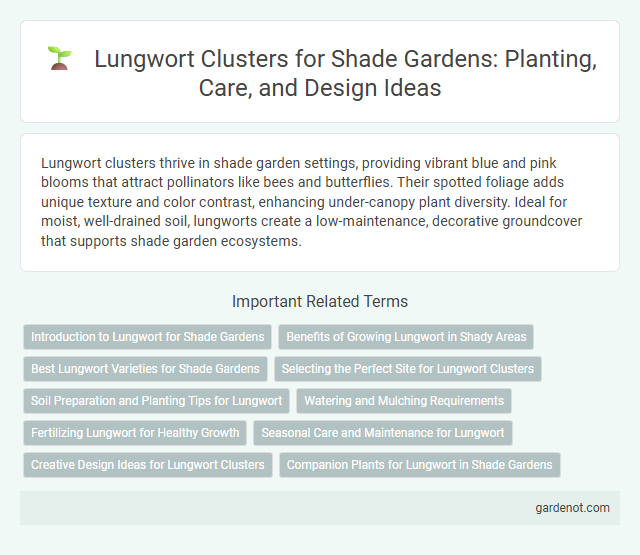Lungwort clusters thrive in shade garden settings, providing vibrant blue and pink blooms that attract pollinators like bees and butterflies. Their spotted foliage adds unique texture and color contrast, enhancing under-canopy plant diversity. Ideal for moist, well-drained soil, lungworts create a low-maintenance, decorative groundcover that supports shade garden ecosystems.
Introduction to Lungwort for Shade Gardens
Lungwort (Pulmonaria) thrives in shade gardens with its early spring blooms and attractive, spotted foliage that adds texture and color to low-light areas. This perennial groundcover prefers moist, well-drained soil and offers low-maintenance growth, making it ideal for shaded garden beds or under trees. Its vibrant blue, pink, or purple flowers also support early pollinators, enhancing biodiversity in shaded landscapes.
Benefits of Growing Lungwort in Shady Areas
Lungwort clusters thrive in shady garden spots, offering vibrant early spring blooms that attract pollinators such as bees and butterflies. Their dense foliage improves soil health by retaining moisture and suppressing weeds, reducing maintenance efforts. The plant's tolerance to low light and resistance to deer and rabbits make it an ideal choice for sustainable, low-maintenance shade gardens.
Best Lungwort Varieties for Shade Gardens
Best Lungwort varieties for shade gardens include Pulmonaria 'Blue Ensign' with its striking silver-spotted leaves and vibrant blue flowers, Pulmonaria 'Trevi Fountain' known for its long bloom period and purple-pink blossoms, and Pulmonaria saccharata 'Mrs. Moon' which offers white-spotted foliage and pale pink blooms. These varieties thrive in shaded, moist soil conditions and provide excellent ground cover with their dense, evergreen leaves. Lungwort's adaptability to low-light environments makes them ideal for enhancing the texture and color in shade garden landscapes.
Selecting the Perfect Site for Lungwort Clusters
Lungwort clusters thrive in moist, well-drained soil enriched with organic matter, ideally situated in partial to full shade environments to mimic their native woodland habitat. Selecting a site with dappled sunlight and protection from harsh afternoon sun ensures vibrant foliage and prolonged blooming periods. Incorporating mulched beds improves moisture retention and supports the lungwort's preference for consistently cool root conditions.
Soil Preparation and Planting Tips for Lungwort
Lungwort thrives in well-drained, humus-rich soil with a pH ranging from 6.0 to 7.0, making soil preparation critical for optimal growth. Incorporate organic matter such as compost or leaf mold to improve soil texture and moisture retention before planting. Space lungwort plants 12 to 18 inches apart to ensure adequate air circulation and reduce the risk of fungal diseases.
Watering and Mulching Requirements
Lungwort clusters thrive in consistently moist, well-drained soil, requiring regular watering to prevent the soil from drying out, especially during dry spells. Applying a layer of organic mulch around the plants helps retain soil moisture, regulate temperature, and suppress weeds, creating an ideal microenvironment for healthy growth. Mulch should be replenished annually to maintain its effectiveness in conserving moisture and protecting the roots.
Fertilizing Lungwort for Healthy Growth
Fertilizing Lungwort clusters with a balanced, slow-release fertilizer rich in nitrogen and phosphorus promotes vigorous leaf development and abundant blooms. Applying organic compost or well-rotted manure in early spring enhances soil fertility and moisture retention, creating optimal growing conditions. Regular feeding every 6-8 weeks during the growing season ensures sustained growth and vibrant foliage in shaded garden areas.
Seasonal Care and Maintenance for Lungwort
Lungwort clusters require consistent moisture during the growing season, especially in shaded or partially shaded environments to prevent leaf scorch. In early spring, removing dead foliage encourages new growth and reduces fungal disease risks. Applying a balanced, slow-release fertilizer in spring supports vibrant blooms and healthy foliage throughout the season.
Creative Design Ideas for Lungwort Clusters
Lungwort clusters thrive in shaded gardens, offering vibrant blue, pink, and white spotted flowers that create striking focal points beneath trees or along shaded borders. Designing lungwort clusters with contrasting foliage plants like hostas and ferns enhances texture and visual interest while maintaining moisture levels in the soil. Incorporating moss or mulch around the clusters improves soil health and enriches the garden's aesthetic with natural layering effects.
Companion Plants for Lungwort in Shade Gardens
Lungwort (Pulmonaria) thrives in shade gardens and pairs well with ferns, hostas, and astilbes, enhancing both texture and color contrast. Companion plants like Heuchera and Tiarella complement Lungwort's early spring blooms while sharing similar moisture and soil requirements. This combination creates a diverse, low-maintenance shade garden with extended seasonal interest.
Lungwort cluster Infographic

 gardenot.com
gardenot.com